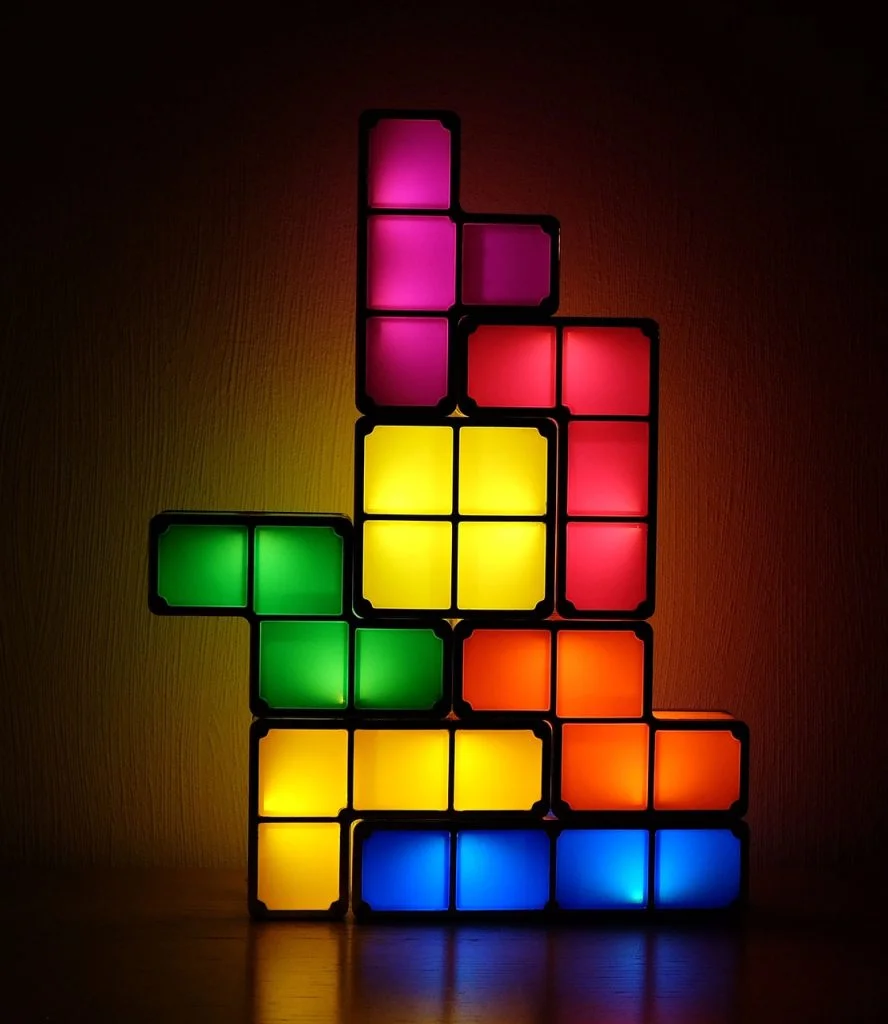You know you’re a Tetris master when you’ve dreamt of those little blocks falling from the sky, only to wake up and realize you were just trying to make them fit into your bedroom! Ah, Tetris, the game that made me cancel dinner plans, lose track of time, and even rethink the way I pack my suitcase.
Seriously, have you tried to Tetris-pack your luggage, or is it just me? How many times have you seen a row of items and thought, “Oh, that’s a perfect ‘T’ shape!”? Join me as I drop, twist, and turn through 50 incredible facts about our beloved block game.
In Tetris, just like in life, if you fit in you disappear.
Unknown
Tetris Facts
Stack your knowledge as you uncover these Tetris facts. And don’t forget, there’s a Tetris trivia challenge at the end to test your expertise! Don’t disappoint me.
- Tetris originated in 1984, crafted by a Russian software engineer, Alexey Pajitnov.
- Its initial development was on an Elektronika 60 computer.
- “Tetris” is a name that comes from the Greek word “tetra,” signifying four, as every piece in the game comprises four segments.
- In Tetris, the game pieces are referred to as Tetriminos.
- Seven unique Tetriminos exist, each constructed of four square segments.
- The game was the first recreational software that the USSR exported to the United States.
- Originally, the Soviet government had ownership of the game’s rights.
- 1989 saw the launch of Tetris on the Game Boy, cementing its global fame.
- The Game Boy Tetris version saw global sales surpass 35 million copies.
- A Russian folk melody titled “Korobeiniki” is the foundation of the Tetris theme song.
- The phenomenon of the Tetris Effect refers to the impact of devoting extensive time to an activity, which influences one’s thoughts and dreams. It is named after the game.
- Scientific research on Tetris has suggested its potential for alleviating PTSD symptoms.
- “Hatris,” a version where hats are stacked instead of blocks, was introduced.

- Tetris 99, a battle royale iteration, was unveiled on the Nintendo Switch in 2019.
- Every year, the Tetris World Championships are organized, celebrating the best global players.
- A standard set of rules known as the “Tetris Guideline” is officially recognized for the game.
- Only in 1996 did Alexey Pajitnov start receiving royalties, a dozen years post-creation.
- A Tetris adaptation titled Bioluminescent Tetris employs bioluminescent bacteria as its pieces.
- MIT featured a version of Tetris played on a building‘s facade using LEDs in 2009.
- Having been featured on more than 65 platforms, Tetris boasts extensive porting.
- Tetris Battle on Facebook had a phase where it drew over a million daily gamers.
- Immersive engagement in the game, leading to a state of flow, is termed “Tetris Zone.”
- In 1996, Alexey Pajitnov and Henk Rogers established the Tetris Company, the current rights holder.
- “Welltris,” resembling Tetris but in a 3D well, was also developed.
- The NES version of Tetris had a maximum attainable score of 999,999 points.
- Various artworks, like sculptures, have drawn inspiration from the game.
- Survival and line clearance were the sole focuses of Tetris’s first version, devoid of scores or levels.
- An Endless mode in Tetris persists until the player’s defeat.
- A “7-bag” or “random generator” system governs the random generation of Tetris pieces, offering a random sequence of each of the seven Tetriminos.

- The first International Tetris Championship took place in 2010.
- In 2004, a mini-game mirroring Tetris utilized crystals and DNA in its gameplay.
- Legal issues arose due to “Tetris Pro,” a clone mirroring the original closely.
- The first Tetris version lacked a “hold” feature, preventing piece reservations for future use.
- Pieces comprising five squares in Tetris are termed “Pentomino.”
- By 2010, over 100 million downloads were recorded for the mobile Tetris version released in 2001.
- Studies by a neuroscientist revealed Tetris’s capability to augment the brain’s gray matter.
- 2009 saw a Philadelphia skyscraper transform into a vast Tetris game during a tech event.
- A sub-20 seconds record exists for completing 40 Tetris lines.
- A version, “First-Person Tetris,” available on the official site, revolutionizes the gameplay by rotating the entire viewport instead of individual pieces.
- An April Fools’ special, “Notris,” featured non-rotating blocks.

- Exceptional venues like water fountains and building exteriors have hosted the game.
- Despite initial color variations in Tetriminos, standardized colors were established by the Tetris Company in the 2000s.
- 1992 witnessed the introduction of a dual-player Tetris version, “Tetris Battle Gaiden.”
- Engaging in Tetris is believed to diminish cravings like the urge to eat or smoke, based on psychological research.
- Tetris has been instrumental in educational settings for imparting spatial and geometrical knowledge to students.
- The game’s inventor, Alexey Pajitnov, expressed a preference for the “T-shaped” Tetrimino.
- A sequel, “Tetris 2,” emerged, embodying a distinctive gameplay approach compared to its predecessor.
- 1997 saw the introduction of “Tetrisphere” for the Nintendo 64, incorporating a 3D sphere into its gameplay.
- The 80s and 90s were marked by intense legal struggles over Tetris’s ownership rights.
- A record exists for surpassing 4,000 line clearances in Tetris.
Tetris Myths

I’m sure you feel like a Tetris master after all the facts. But now it’s time to bust some myths around the game.
- The Name ‘Tetris’ Is Random
Ever heard of the Greek word “tetra“, meaning four? That’s because every piece in Tetris has four squares. Cool, right? - A large game company developed Tetris.
Nope! It was the brainchild of Alexey Pajitnov, a guy from Moscow who was just tinkering around in 1984. Talk about a DIY success! - There’s No Strategy in Tetris. It’s Purely Random
Think Tetris is just luck? Think again! The pros know it’s all about spotting patterns and thinking two steps ahead. It’s a mental workout! - Tetris Has Always Been the Same Game
You’d be surprised! Over the years, Tetris has had makeovers with new modes, scoring tweaks, and even some fancy block changes. - Tetris Is Just a Game
Just a game? Besides being wicked fun, Tetris might actually boost your brain! Some folks even say it helps them think clearly and shake off bad memories. Who knew?
No products found.
Tetris FAQ

We are really close to finishing the article with the Tetris trivia, but till then, let’s see some questions that pop up if you search about the game online.
- When was Tetris invented?
Oh, Tetris is an oldie, but Goldie! Alexey Pajitnov came up with it back in 1984 over in Moscow. - What is a “tetris” in Tetris?
Ever cleared four lines in one move using that straight piece? Boom! That’s a “tetris” right there. - Is Tetris good for your brain?
Believe it or not, Tetris is like a mini-workout for your brain. It boosts spatial skills, problem-solving, and memory. - How is Tetris scored?
It’s all about clearing those lines. The more you clear at once, the bigger the points. - What is the Tetris Effect?
Played Tetris so much that you started fitting boxes together in your head or saw blocks when you closed your eyes? Yep, that’s the Tetris Effect!
Tetris Trivia

It’s time for the quiz. Fail to score a single correct answer, and you might just find your life blocks not falling into place.
Conclusion
Well, there you have it, folks: Tetris, the game where we all tried fitting oddly shaped blocks into our lives (literally). If you ever feel like you’re bad at adulting, just remember that somewhere, someone is trying to fit a long piece horizontally.
Let that sink in. Now, here’s a question for you: What’s the silliest mistake you’ve ever made in a game of Tetris? Let me know in the comments.


